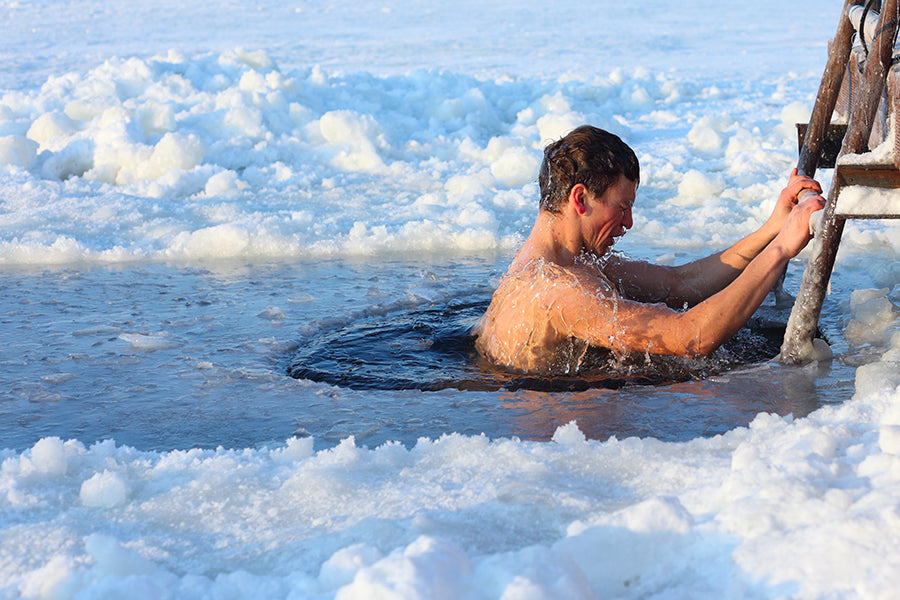History tells us that people from different cultures worldwide have been using ice-cold baths for various health benefits. One of the benefits that people have been claiming to get from ice plunges is fat burn.
It may seem like a dream to lose weight with cold baths for many as one does not have to put in too much effort to get their dream body with this. All one needs to do is submerge their body into ice-cold water a few times a week, and tada! They may shed the hard stuck calories that were not melting for weeks.
It seems almost unbelievable, right? Do you want to find out if it works, or is it just a myth? Let’s dig in to see what science says about it.
Related Article: Weight Loss Vs. Fat Loss: What’s the Difference?
Does Science Support That Ice Baths Can Help With Weight Loss?
The idea that taking an ice bath can help with weight loss is widely debated in the scientific community. However, some studies have suggested that cold exposure may increase metabolic rate, so the subjects may effectively lose weight if they practice ice bathing consistently for some time.
An additional benefit of ice baths is the prevention of muscle soreness due to exercise or injury.
The research that supports the concept that ice baths may help with weight loss do so based on a scientific theory called ‘Cold Thermogenesis.’ Now, what is ‘Cold Thermogenesis’? We will first have to understand the thermogenesis process to grasp the meaning of cold thermogenesis.
What is Thermogenesis?
Thermogenesis is the process of producing heat in the body. It can be triggered by exercise or when your body needs to regulate its temperature. The concept implies that a person may lose weight if exposed to a higher temperature due to physical activity or other factors.
The phenomena also play a role in hunger and appetite control, as it is directly related to levels of certain hormones in the body responsible for regulating these sensations.
When thermogenesis causes an increase in hormone levels, it can suppress hunger and reduce appetite. The opposite is also true; when thermogenesis decreases, so does the level of these hormones, resulting in an increased sensation of hunger and a greater desire to eat.
Understanding how thermogenesis impacts our feelings of hunger and appetite can help us better control our food consumption with the tactic. One can even combine it with fat burner pills to reap quicker results.
Now, moving to cold thermogenesis. There is also a similar concept in science explaining how the human body reacts to colder temperatures. The concept is called ‘Cold Thermogenesis’ and is also claimed to help with weight loss. Let’s understand it in depth to see how it works.
What is Cold Thermogenesis?
Cold thermogenesis, also known as Cold-induced Thermogenesis (CIT), translates into intentionally exposing the body to cold temperatures to increase metabolism, burn fat, and potentially even improve mood. It involves taking cold showers or baths, engaging in cold water sports, or simply spending time outdoors during winter.
While it may sound counterintuitive to expose yourself to colder temperatures when it's chilly out, cold thermogenesis can be a powerful tool in weight loss and overall health. Research has shown that exposure to cold temperatures activates brown adipose tissue (BAT), which is responsible for non-shivering thermogenesis — burning calories in response to cold exposure.
When our body is forced to sustain itself in a colder environment, it activates resting energy expenditure (REE). It uses the reserved body's energies to stabilize the core temperature of the body. The process tends to produce heat to counterbalance heat loss due to low outside temperatures.
Now it makes sense. So it’s time to find the correct way to perform ice baths for weight loss to acquire the maximum benefits.
How to Perform Ice Baths for Weight Loss?
Before we explain the right way to expose yourself to cold water, it is crucial to understand that ice bathing is something only some will like and be able to tolerate, as it can have an impact on one’s physical and mental health.
This is why it is recommended that one should not try cold bathes straight away without first introducing themselves to lower temperatures. One way to do that is to start with simple cold showers and do it for a week to get used to it.
Once your body is familiar with lower temperature exposure, you can go for proper ice-cold baths. Here are the steps to perform an ice bath for desired results:
- Fill a bathtub with cold water and add ice cubes to make sure that the temperature gets as low as possible
- Next, get into the tub and stay there for 10-15 minutes. Do not stay in the tub for more than 20 minutes
- Finally, get out of the tub and towel off properly to make so that you are completely dry
It’s important to note that you should never stay in the ice bath longer than 15-20 minutes, as this can be dangerous for your health.
After completing an ice bath, rehydrate yourself by drinking plenty of fluids to avoid any health issues. In addition, you should also ensure to consume a balanced diet to maintain healthy glucose levels. You can also add an excellent supplement to your diet to get all the needed nutrients for keeping healthy.
Related Article: Bone Broth Diet: Does It Work for Weight Loss?
Risk Factors: Who Should Not Take Cold Baths for Weight Loss?
Those considering cold baths should know that there are certain risks involved in this treatment for weight loss. Here is a list of people who should not try cold baths for weight loss or any other cure, as they can harm them.
Not Suitable for Cardiovascular Conditions or Low Blood Pressure Patients
According to research, people with cardiovascular conditions or blood pressure disease should not opt for ice baths as the activity can cause adverse and even fatal effects.
The research explains that cold water immersion causes the core body temperature to drop immediately and slows blood flow. This can lead to cardiac arrest or a stroke, specifically for those already suffering from a heart condition or low blood pressure.
People with no heart condition or bp issues still need to take precautions, eat proper meals, and keep themselves hydrated before they shower with ice-cold water. However, taking a cold or a hot shower is not recommended immediately after having a full meal, so one should wait for at least 20 to 30 minutes after having food.
Not Suitable for Type 1 and Type 2 Diabetes Patients
As observed by medical researchers, exposure to cold temperatures can also be harmful to people with type 1 and 2 diabetes. That’s because their ability to maintain a stable body temperature during a sudden temperature change weakens due to the disease.
Risk of Developing Hyperthermia
Hyperthermia is when the body's temperature rises abnormally high, which can be potentially dangerous. It is essential to exercise caution when taking cold baths as they may increase your risk of developing hyperthermia. Cold water can increase the risk of hypothermia as the body tries to raise its temperature while exposed to it, and this could be life-threatening if not managed properly.
FAQs
1. How long should you take an ice bath to lose weight?
Ice baths, known as cold water immersion, are popular weight loss strategies. Experts recommend that you stay in your cold bath for no longer than 10-20 minutes at a time. Any longer than this, and you risk hypothermia or other health complications.
2. Do you burn calories in an ice bath?
According to research, cold thermogenesis can help one lose weight if combined with a suitable diet plan. So yes, a cold water bath can help you burn calories.
When the water temperature is colder than your body's average core temperature, it causes an increase in metabolism and energy expenditure as your body tries to keep itself warm. This means that while taking an ice bath won't likely result in dramatic weight loss, it could help with gradual, consistent weight loss over time if you stay in a caloric deficit.
3. How many calories does a 10-minute cold bath burn?
A 10-minute cold bath may burn 10 to 20 extra calories because the cold exposure increases the metabolic rate by only 1 to 2 calories per minute.
A person choosing for Cold Thermogenesis Treatment can stay in cold water for up to 15 to 20 minutes, so this method is not very fast for weight loss.
Conclusion
To summarize, ice baths, also known as cold water immersion, are a weight loss treatment where you submerge yourself in an ice-cold bath for a set time. The idea is that forcing your body to adapt to extreme cold conditions can help you burn fat and calories more quickly.
However, one has to take precautions before using this treatment as cold plunges can also have harmful effects such as cold, lung infection, low blood sugar, and so on. So to avoid these and get the maximum benefits, one must follow the rule of not taking cold baths longer than 15 minutes and make sure to dry themselves as soon as they are out. Also, having a nutritious diet and lots of fluids is very important for anyone planning to try ice baths to lose weight.
Reading List
Article Sources
- “6 Ice Bath Benefits That May Convince You to Take the Plunge (2022).” Tfbears, 4 July 2022, https://tfbears-com.ngontinh24.com/article/6-ice-bath-benefits-that-may-convince-you-to-take-the-plunge.
- Blundell, J. E., et al. “Appetite Control and Energy Balance: Impact of Exercise: Appetite Control and Exercise.” Obesity Reviews, vol. 16, Feb. 2015, pp. 67–76. DOI.org (Crossref), https://doi.org/10.1111/obr.12257.
- Carter, W. J. “Effect of Anabolic Hormones and Insulin-like Growth Factor-I on Muscle Mass and Strength in Elderly Persons.” Clinics in Geriatric Medicine, vol. 11, no. 4, Nov. 1995, pp. 735–48.
- Cypess, Aaron M., et al. “Cold but Not Sympathomimetics Activates Human Brown Adipose Tissue in Vivo.” Proceedings of the National Academy of Sciences of the United States of America, vol. 109, no. 25, June 2012, pp. 10001–05. PubMed Central, https://doi.org/10.1073/pnas.1207911109.
- Dahmane, Raja, et al. “Spatial Fiber Type Distribution in Normal Human Muscle Histochemical and Tensiomyographical Evaluation.” Journal of Biomechanics, vol. 38, no. 12, Dec. 2005, pp. 2451–59. PubMed, https://doi.org/10.1016/j.jbiomech.2004.10.020.
- Espeland, Didrik, et al. “Health Effects of Voluntary Exposure to Cold Water – a Continuing Subject of Debate.” International Journal of Circumpolar Health, vol. 81, no. 1, Dec. 2022, p. 2111789. DOI.org (Crossref), https://doi.org/10.1080/22423982.2022.2111789.
- Morán-Navarro, Ricardo, et al. “Load-Velocity Relationship of the Deadlift Exercise.” European Journal of Sport Science, vol. 21, no. 5, May 2021, pp. 678–84. DOI.org (Crossref), https://doi.org/10.1080/17461391.2020.1785017.
- Nonshivering Thermogenesis - an Overview | ScienceDirect Topics. https://www.sciencedirect.com/topics/medicine-and-dentistry/nonshivering-thermogenesis. Accessed 12 Dec. 2022.
- Parker, Robert. “How Deadlifts Benefit Testosterone Release.” TestoFuel Blog, 29 Mar. 2016, https://www.testofuel.com/tf/deadlifts-benefit-testosterone-release/.











